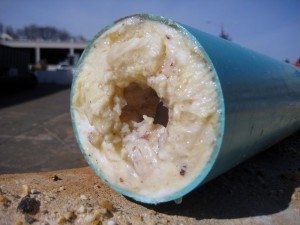Fats, oils, grease (FOG) and wipes represent the most serious enemy of our sewer lines. FOG creates clogs; Protect your pipes, don't flush wipes!  (JPG, 722KB)
(JPG, 722KB)
- Fats: Butter, margarine, shortening, meat scraps
- Oils: Cooking oil, mayonnaise, salad dressing
- Grease: Gravy, lard, sauces
- Wipes and other un-flushables: Baby wipes, cleaning wipes, paper towels, tissues, feminine hygiene products, or trash of any kind. Even if it is labeled as flushable, don't believe the hype: never flush your wipes.
When FOG is poured down the sink drain or wipes are flushed, it forms large, thick masses that clog pipes. Clogged wastewater pipes can result in sewer backups and spills, create environmental problems, cause traffic tie-ups or even flood homes and businesses. Responding to pipe emergencies is costly, and preventing sewer backups from FOG and wipes blockages saves money.
Commercial food-handling facilities can contribute to FOG buildup in sewer lines because of the amount of grease used in cooking and other food prep work. Learn more about proper handling of grease and oil in restaurants and other businesses.
Important: When sewer pipes back up on private property, the homeowner or business owner is responsible for the cleanup.

A pipe clogged with thick fats, oil and grease, also known as FOG.